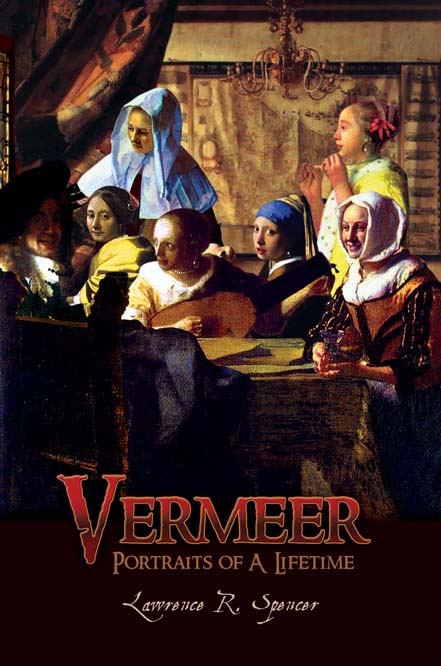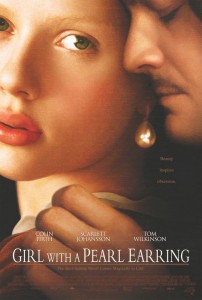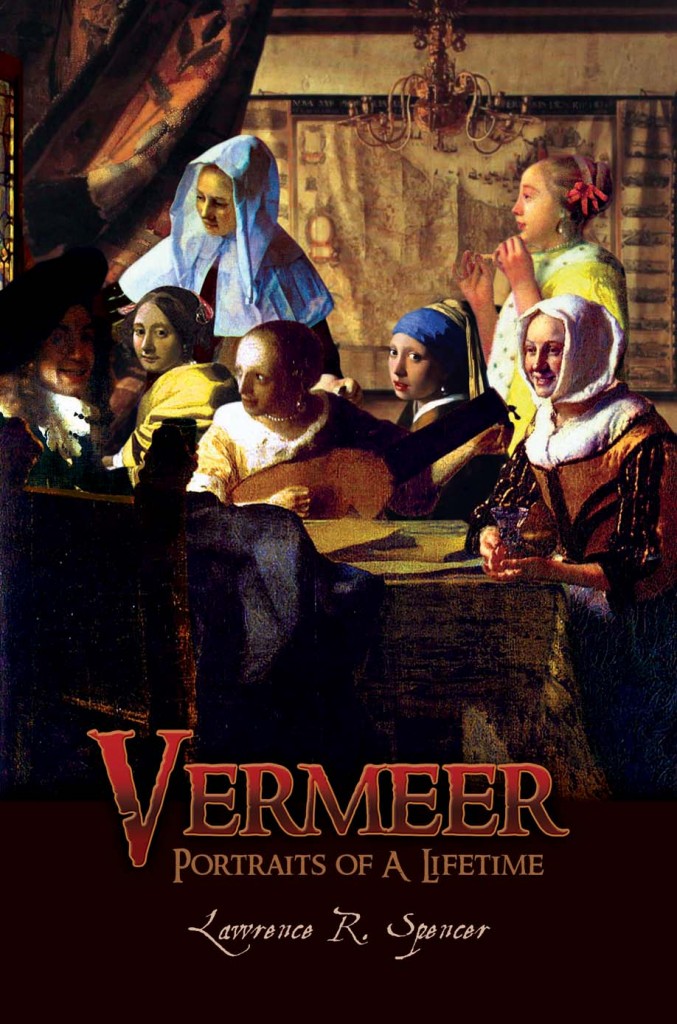Republished by Blog Post Promoter
Category Archives: VERMEER REVEALED
Vermeer: Portraits of A Lifetime explores the life of the world famous Dutch artist, Johannes Vermeer. This book reveals observations that have never before been made about his paintings, his life, his friends and his family. Dedicated to revealing observations about the life and paintings of Vermeer, and the women featured in his painting — his family.
GIRL WITH A PEARL
Republished by Blog Post Promoter

 It is lovely to see that a Vermeer painting has been returning to Holland after being “on tour”. Personally, I am greatly saddened that Vermeer, his wife Catharina, and their children did not enjoy the immense financial rewards that art promoters have received during recent decades from his paintings, during his own lifetime! Within the context of the Eternal Now, financial rewards is irrelevant. However, acknowledgment, in the form of recognition of technical brilliance and praise of aesthetic artistry, are always welcome to any Immortal Being. (Read the article about the Vermeer painting, “Girl withe a pearl earring” being returned to Holland after two years): http://www.independent.co.uk/arts-entertainment/art/news/vermeers-girl-with-a-pearl-earring-to-return-home-to-the-netherlands-after-two-years-on-the-road-as-mauritshuis-royal-picture-gallery-reopens-9158240.html
It is lovely to see that a Vermeer painting has been returning to Holland after being “on tour”. Personally, I am greatly saddened that Vermeer, his wife Catharina, and their children did not enjoy the immense financial rewards that art promoters have received during recent decades from his paintings, during his own lifetime! Within the context of the Eternal Now, financial rewards is irrelevant. However, acknowledgment, in the form of recognition of technical brilliance and praise of aesthetic artistry, are always welcome to any Immortal Being. (Read the article about the Vermeer painting, “Girl withe a pearl earring” being returned to Holland after two years): http://www.independent.co.uk/arts-entertainment/art/news/vermeers-girl-with-a-pearl-earring-to-return-home-to-the-netherlands-after-two-years-on-the-road-as-mauritshuis-royal-picture-gallery-reopens-9158240.html
Read MY THOUGHTS about Hollywood film, excerpted from my book VERMEER: PORTRAITS OF A LIFETIME:
 “Recasting The Girl, Spray-Painting The Pearl
“Recasting The Girl, Spray-Painting The Pearl
| I |
will not soon forget seeing the horrendous Hollywood movie titled, “The Girl With A Pearl Earring” in 2004. It is a fictional depiction of a fictionalized relationship between Vermeer and an imagined “…young peasant maid working in the house of painter Johannes Vermeer becomes his talented assistant and the model for one of his most famous works.” It was nominated for 3 Oscars by the Academy of Motion Picture “arts” and “sciences”.
This tragically tacky spin on the life of Vermeer is classic Hollywood magic: take the true life story of a teen-age daughter of one of the finest painters in history, re-cast her as whore, and her father as an brutish ogre, spray-paint her naturally luminescent pearl earring with glitter glue and, presto! Nominate it for an Oscar!
Absurdly cliché characterizations contrived by the brain-dead writers invent a debased relationship between a fictional “peasant maid” and Vermeer that are typical of the money-motivated Hollywood swill fed to and gobbled up by an uneducated public. The socially redeeming value of this food for swine (to be polite) is a pile of steaming shit! Sexual intrigue may sell movie tickets, but pigs are stupid, and shit stinks.
The writers, producers and actors associated with this morose movie would have been more kind to Vermeer, his family and his artistic legacy if they had spent the budget for the film to visit the museums of the world, in which his priceless works hang, and spray them with graphic graffiti.
The film was written and directed without regard for historic fact or common sense. The preposterous personae of Vermeer was portrayed by the British actor, Colin Firth, with the charisma of a cardboard cereal box. Scarlett Johansson, who plays the role of the gawkish “girl”, is garish at best.
The premise of the ludicrous book and movie script, entirely ignores and abuses the obvious, and thoroughly researched historical information about Vermeer and his life. A few of the grossest omissions are:
1) All of the women in the Vermeer paintings, with one or two minor exceptions, are his wife, and daughters. To postulate that he hired a “peasant maid”, or that he had a painting assistant, much less that he had a sexual relationship with such an imaginary person, are sick, fictional contrivances.
2) That the Vermeers could afford to pay a servant, who could spare the time away from vitally needed chores, to become an artists assistant, is blatantly stupid. Household helpers were not something they could afford, except early in their marriage, at best. Some of the thoroughly researched facts about Vermeer were that he and his wife produced 15 children in 22 years! They lived in the small village of Delft, with his wife’s very Catholic mother, in her small house, to help reduce expenses. He died from overwhelming depression due to his inability to support his wife and 11 surviving children, who were left in extreme poverty at his premature death at the age of 43.
In a plea to her creditors after her husband’s death Catharina stated, in the public record, the final footnotes to Vermeer’s brief life:
“during the ruinous war he not only was unable to sell any of his art but also, to his great detriment, was left sitting with the paintings of other masters that he was dealing in.”
Catharina summarized the circumstances of his death: “as a result and owing to the great burden of his children, having no means of his own, he had lapsed into such decay and decadence, which he had so taken to heart that, as if he had fallen into a frenzy, in a day or day and a half had gone from being healthy to being dead.”
Obviously, the man she describes is the antithesis of the man portrayed in the movie.
3) That a woman would be allowed to become an artists apprentice or assistant, is an absurd fantasy. It was forbidden by the Guild of St. Luke which maintained strict, Puritanical oversight of the activities of every member.
4) It is a documented fact that Maria Thins employed a live-in servant woman in her home in the later years of her life. (Born ca. 1593 – died, December 27, 1680) Maria was 82 years old when Vermeer died in 1675 at the age of 43. Her servant’s name was Tanneke Everpoel. Maria bequeathed a small sum of money (20 guilders) to Tanneke upon her death. It is very likely that Tanneke is the servant shown in Vermeer’s painting, ” The Love Letter”.
5) The girl in the legendary painting (as well as in several other of his paintings) is his second daughter, Elizabeth! Vermeer never hired models — he painted only family and friends. It doesn’t take a cosmetic surgeon to compare the features of the women in the majority of his paintings to observe that the same women are being painted in their own home, again and again in different poses, settings, lighting and clothing. Most of his paintings feature his wife, Catharina, who was not only his constant accomplice in creating a family, she was his foremost ally in his life as an artist!
The paintings named (by others), “girl with a pearl earring”, as well as “the girl with a red hat”, and “the girl with a flute”, and others, are all of his second daughter, Elizabeth, who was a teenager when they were painted. He used her as the model for a series of very small “tronie” or facial portraits, which were popular at the time.
These miniature “head shots” were especially well suited to the use of the camera obscura to create what we know now to have a photographic quality, rendering the light and perspective differently than the unaided lens of the human eye perceives it.
The women in his family, during his lifetime, enjoyed dressing in the finest clothes and jewelry available to them, as well as exotic costumes, imitating the apparel of mysterious lands. Many of the accessories included in these paintings were borrowed. Trading vessels often brought fascinated news and relics to Delft from around the world. He and his family rarely ventured more than a short walk or boat ride from home.
That Vermeer would have an elicit affair with a maid in his own home is an insult to common sense and decency. Anyone who looks at paintings of his wife and nine daughters can plainly see his obvious love and devotion — if not obsession — for the women in the small house they shared. Vermeer’s family permeated every aspect of his life, and dominated his home.
His days were consumed with his work with the Guild of St. Luke, the militia of Delft, and interaction with other painters for whom, like his father before him, he sold their paintings to earn money to feed and clothe his 15 children. As his family grew, Vermeer barely had time work on his own paintings!
That there was ever any enmity or discord between Johannes and Catharina during their lives is a fantasy contrived by the Hollywood money machine that perverts reality to appeal to the lowest common denominator of prurient interest suitable only for soap operas, pornography, and girl-gossip magazines.
The self-proclaimed “artists” of Hollywood, driven by money mongers, like any mindless mercenary who act the part they’re paid for, notoriously devoid of ethics or integrity, are akin to any common soldier who massacres innocent civilians, and justifies their crimes in the name of war.
Vermeer, in this movie, and in his own lifetime, was a victim of brainless brutality. The stupid soldiers of Louis XIV of France who invaded Holland, together with the bloody British aristocracy combined to murder peasants, and plunder goods to enrich and glorify themselves. The net result for Vermeer was attested, after his death, by his wife, Catharina Bolnes, “during the ruinous war he not only was unable to sell any of his art but also, to his great detriment, was left sitting with the paintings of other masters that he was dealing in.” And further, “as a result and owing to the great burden of his children, having no means of his own, he had lapsed into such decay and decadence, which he had so taken to heart that, as if he had fallen into a frenzy, in a day or day and a half had gone from being healthy to being dead.”
Let us hope, sincerely, that those unfortunates who saw this “ruinous movie” can assess for themselves the denigrating massacre of an artist by Hollywood, compared with his own biographical portraits of a lifetime and the family he adored, magnificently embodied in his paintings, to judge for themselves the aesthetic intention and ethical integrity of the man, Vermeer.
— Lawrence R. Spencer
Recasting The Girl, Spray-Painting The Pearl
Republished by Blog Post Promoter
I will not soon forget seeing the horrendous Hollywood movie titled, “The Girl With A Pearl Earring” in 2004. It is a fictional depiction of a fictionalized relationship between Vermeer and an imagined “…young peasant maid working in the house of painter Johannes Vermeer becomes his talented assistant and the model for one of his most famous works.” It was nominated for 3 Oscars by the Academy of Motion Picture “arts” and “sciences”.
 This tragically tacky spin on the life of Vermeer is classic Hollywood magic: take the true life story of a teen-age daughter of one of the finest painters in history, re-cast her as whore, and her father as an brutish ogre, spray-paint her naturally luminescent pearl earring with glitter glue and, presto! Nominate it for an Oscar!
This tragically tacky spin on the life of Vermeer is classic Hollywood magic: take the true life story of a teen-age daughter of one of the finest painters in history, re-cast her as whore, and her father as an brutish ogre, spray-paint her naturally luminescent pearl earring with glitter glue and, presto! Nominate it for an Oscar!
Absurdly cliché characterizations contrived by the brain-dead writers invent a debased relationship between a fictional “peasant maid” and Vermeer that are typical of the money-motivated Hollywood swill fed to and gobbled up by an uneducated public. The socially redeeming value of this food for swine (to be polite) is a pile of steaming shit! Sexual intrigue may sell movie tickets, but pigs are stupid, and shit stinks.
The writers, producers and actors associated with this morose movie would have been more kind to Vermeer, his family and his artistic legacy if they had spent the budget for the film to visit the museums of the world, in which his priceless works hang, and spray them with graphic graffiti.
The film was written and directed without regard for historic fact or common sense. The preposterous personae of Vermeer was portrayed by the British actor, Colin Firth, with the charisma of a cardboard cereal box. Scarlett Johansson, who plays the role of the gawkish “girl”, is garish at best.
The premise of the ludicrous book and movie script, entirely ignores and abuses the obvious, and thoroughly researched historical information about Vermeer and his life. A few of the grossest omissions are:
1) All of the women in the Vermeer paintings, with one or two minor exceptions, are his wife, and daughters. To postulate that he hired a “peasant maid”, or that he had a painting assistant, much less that he had a sexual relationship with such an imaginary person, are sick contrivances.
2) That the Vermeers could afford to pay a servant, who could spare the time away from vitally needed chores, to become an artists assistant, is blatantly stupid. Household helpers were not something they could afford, except early in their marriage, at best. Some of the thoroughly researched facts about Vermeer were that he and his wife produced 15 children in 22 years! They lived in the small village of Delft, with his wife’s very Catholic mother, in her small house, to help reduce expenses. He died from overwhelming depression due to his inability to support his wife and 11 surviving children, who were left in extreme poverty at his premature death at the age of 43.
In a plea to her creditors after her husband’s death Catharina stated, in the public record, the final footnotes to Vermeer’s brief life:
“during the ruinous war he not only was unable to sell any of his art but also, to his great detriment, was left sitting with the paintings of other masters that he was dealing in.”
Catharina summarized the circumstances of his death: “as a result and owing to the great burden of his children, having no means of his own, he had lapsed into such decay and decadence, which he had so taken to heart that, as if he had fallen into a frenzy, in a day or day and a half had gone from being healthy to being dead.”
Obviously, the man she describes is the antithesis of the man portrayed in the movie.
3) That a woman would be allowed to become an artists apprentice or assistant, is an absurd fantasy. It was forbidden by the Guild of St. Luke which maintained strict, Puritanical oversight of the activities of every member.
 4) The girl in the legendary painting (as well as in several other of his paintings) is his second daughter, Elizabeth! Vermeer never hired models — he painted only family and friends. It doesn’t take a cosmetic surgeon to compare the features of the women in the majority of his paintings to observe that the same women are being painted in their own home, again and again in different poses, settings, lighting and clothing. Most of his paintings feature his wife, Catharina, who was not only his constant accomplice in creating a family, she was his foremost ally in his life as an artist!
4) The girl in the legendary painting (as well as in several other of his paintings) is his second daughter, Elizabeth! Vermeer never hired models — he painted only family and friends. It doesn’t take a cosmetic surgeon to compare the features of the women in the majority of his paintings to observe that the same women are being painted in their own home, again and again in different poses, settings, lighting and clothing. Most of his paintings feature his wife, Catharina, who was not only his constant accomplice in creating a family, she was his foremost ally in his life as an artist!
The paintings named (by others), “girl with a pearl earring”, as well as “the girl with a red hat”, and “the girl with a flute”, and others, are all of his second daughter, Elizabeth, who was a teenager when they were painted. He used her as the model for a series of very small “tronie” or facial portraits, which were popular at the time.
These miniature “head shots” were especially well suited to the use of the camera obscura to create what we know now to have a photographic quality, rendering the light and perspective differently than the unaided lens of the human eye perceives it.
The women in his family, during his lifetime, enjoyed dressing in the finest clothes and jewelry available to them, as well as exotic costumes, imitating the apparel of mysterious lands. Many of the accessories included in these paintings were borrowed. Trading vessels often brought fascinated news and relics to Delft from around the world. He and his family rarely ventured more than a short walk or boat ride from home.
That Vermeer would have an elicit affair with a maid in his own home is an insult to common sense and decency. Anyone who looks at paintings of his wife and nine daughters can plainly see his obvious love and devotion — if not obsession — for the women in the small house they shared. Vermeer’s family permeated every aspect of his life, and dominated his home.
His days were consumed with his work with the Guild of St. Luke, the militia of Delft, and interaction with other painters for whom, like his father before him, he sold their paintings to earn money to feed and clothe his 15 children. As his family grew, Vermeer barely had time work on his own paintings!
That there was ever any enmity or discord between Johannes and Catharina during their lives is a fantasy contrived by the Hollywood money machine that perverts reality to appeal to the lowest common denominator of prurient interest suitable only for soap operas, pornography, and girl-gossip magazines.
The self-proclaimed “artists” of Hollywood, driven by money mongers, like any mindless mercenary who act the part they’re paid for, notoriously devoid of ethics or integrity, are akin to any common soldier who massacres innocent civilians, and justifies their crimes in the name of war.
Vermeer, in this movie, and in his own lifetime, was a victim of brainless brutality. The stupid soldiers of Louis XIV of France who invaded Holland, together with the bloody British aristocracy combined to murder peasants, and plunder goods to enrich and glorify themselves. The net result for Vermeer was attested, after his death, by his wife, Catharina Bolnes, “during the ruinous war he not only was unable to sell any of his art but also, to his great detriment, was left sitting with the paintings of other masters that he was dealing in.” And further, “as a result and owing to the great burden of his children, having no means of his own, he had lapsed into such decay and decadence, which he had so taken to heart that, as if he had fallen into a frenzy, in a day or day and a half had gone from being healthy to being dead.”
Let us hope, sincerely, that those unfortunates who saw this “ruinous movie” can assess for themselves the denigrating massacre of an artist by Hollywood, compared with his own biographical portraits of a lifetime and the family he adored, magnificently embodied in his paintings, to judge for themselves the aesthetic intention and ethical integrity of the man, Vermeer.
— Lawrence R. Spencer
64 BOOKS I HEARD LAST YEAR
Republished by Blog Post Promoter
 I stopped watching television. I refuse to be “dumbed down” by the “vast wasteland” of insidious drivel produced by the “mind-control media”. I prefer to spend my time with great writers. Like most writers I read a lot of books. In recent years I have become a huge fan of audio books! I listen to at least one book each week on my iPhone.
I stopped watching television. I refuse to be “dumbed down” by the “vast wasteland” of insidious drivel produced by the “mind-control media”. I prefer to spend my time with great writers. Like most writers I read a lot of books. In recent years I have become a huge fan of audio books! I listen to at least one book each week on my iPhone.
Recorded books are read to you, sometimes by the authors themselves, such as Stephen King or Neil Gaiman, while you do the routine hands-free activities of daily living: driving, grocery shopping, riding a bicycle, jogging, walking, cooking, cleaning, washing dishes, eating and pooping.
There are thousands of recorded books available. You can start by downloading a FREE AUDIO BOOK from Audible.com.
This is a list of 64 Audio books I personally enjoyed hearing during the last year (many for the 2nd or 3rd time):
The Riverboat Series (5 books) by Philip Jose Farmer
Shantaram: A Novel by Gregory David Roberts
The Hitchhiker’s Guide to the Galaxy (Series of 6 books, including “And Another Thing”) by Douglas Adams
The Salmon of Doubt by Douglas Adams
The Long Lost Tea Time of The Soul by Douglas Adams
Dirk Gently’s Holistic Detective Agency by Douglas Adams
Ecco Homo by Friedrich Nietzsche
Heresy by S.J. Parris
Prophecy S.J. Parris
Sacrilege S.J. Parris
Touch by Clair North
The First Fifteen Lives of Harry August by Clair North
Escape from Camp 14 by Blaine Harden
Wizard: The Life and Times of Nikola Tesla by Marc J. Seifer
My Inventions by Nikola Tesla
The Art of Happiness by Dalai Lama
Our Occulted History by Jim Marrs
Ubik by Phillip K. Dick
The Hair Potter Series (7 books) by J.K. Rowling
Hyperion by Dan Simmons
The Fall of Hyperion by Dan Simmons
The Domain Expeditionary Rescue Mission by Lawrence R. Spencer
Alien Interview by Matilda MacElroy
Kill Decision by Daniel Suarez
Daemon by Daniel Suarez
Influx by Daniel Suarez
Theft of Swords by Michael J. Sullivan
Hollow World by Michael J. Sullivan
The Republic of Pirates: Being the True and Surprising Story of the Caribbean
Pirates and the Man who brought them down by Colin Woodard
Far Journeys by Robert Monroe
Tao Te Ching by Stephen Mitchell
Off to Be The Wizard by Scott Meyer
Spell and High Water by Scott Meyer
Seize The Night by Dean Koontz
Fear Nothing by Dean Koontz
Ashley Bell by Dean Koontz
Bag of Bones by Stephen King
The John Carter Trilogy by Edgar Rice Burroughs
Neverwhere by Neil Gaiman
The Ocean at The End of The Lane by Neil Gaiman
The Graveyard Boo, by Neil Gaiman
Good Omens by Terry Pratchet and Neil Gaiman
Dune (Series of 7 books) by Frank Herbert
VERMEER — AN EMPATHETIC EXPLORATION
Republished by Blog Post Promoter
Paintings of Johannes Vermeer exhort a mystic awe in the human soul. Aesthetics, women and mystery are each a glue that have baited many of the most powerful traps in history. Vermeer combines all three. Almost nothing factual is known about the painter personally, or the bevy of enchanting women he painted.
Compounding the mystery is the puzzle of identifying the people he painted so repetitively. Apparently, they were nearly all his wife or daughters! Moreover, they were portrayed at various ages in their lives, over a span of twenty-two years during which he and his wife produced an family of 15 children, 11 of whom survived! As a consequence of their common genetic similarities in their physical appearance, they also shared clothing, hair styles, and jewelry. Add to this monochromatic puzzle are identical rooms, windows, lighting, furniture, fixtures and the themes surrounding them. The resulting maelstrom of similarities make differentiating one person from another a near impossibility.
Most of his work, apart from the paintings produced during his six year apprenticeship at the Guild of St. Luke, were portraits of his wife, family and a few close friends. Vermeer never painted his family members, or his self-portrait, with the intention of selling them, any more than you and I would think of selling photographs or home videos of the members of our own family.
He painted people in his surroundings that were close at hand, familiar, and endeared to him. Mostly he painted for the love of aesthetics, and to innovate the technology of painting — to discover new techniques to more exactly render the myriad subtleties of light, and to endow love, and life on canvas, with colors and brushes. Like many artists before and after Vermeer, these challenges intrigued and consumed his interest, intellect and spiritual passion.
Apparently, during his own life, it never occurred to him that anyone would be interested in paying money for many of his paintings. Most of his paintings were still in the possession of his wife when he died prematurely at the age of forty-three! Astoundingly, they were never sold, even though he and his family were literally starving from the want of money to buy food!
According to the research of Vermeer scholar, Anthony Bailey, the value of Dutch money was as follows: “…a Dutch cloth-worker in 1642 got eighteen stuivers a day; there were twenty stuivers to one guilder, and a 6-pound loaf of rye bread coast about four and a half stuivers…”.
Imagine his shock and dismay to discover, 300 years later, that his paintings are worth many millions of dollars! Yet, during his own lifetime, he never earned enough from them to feed his family, and indeed, died from an overwhelming bought of depression because of it.
These facts confound comprehensive and compound the mystery of Vermeer.
In this book, I propose to travel this impossible labyrinth, to discover the long-hidden key to ancient riddles: Who were the people painted by Vermeer? Who was Vermeer, the artist and the man?
As though this were not daunting enough, I propose to do this, in part, by leaping the abyss of 300 years from the present year of 2008, returning through my own experience as an artist, a father, a husband and a man, through my own, personal life experiences, to re-experience the life of Vermeer, as though it were my own!
I do not claim that I am or was Vermeer. Such an assertion would be entirely subjective, impossible to prove, and irrelevant. As do myriad other people fascinated by his art and his life, I have a good deal of personal empathy and common life experiences that I share with this obscure man, as a father, as a parent, as an artist and as a spiritual being. I intend to employ this empathy as a tool of investigation and discovery: just as one might use a divining rod to seek out water in the desert.
As a lost dog uses native intuition to find it’s way home, I am searching for a lost self. As a tourist in Italy feels a sense of deja vu when visiting the Coliseum in Rome: one can almost smell the roar of blood spattering on the sand, and reel at the lust for pain and death oozing from the crowd! And thrill as a blade slashes and vomits entrails to the ground. The spirit writhing to be free of a mangled corpse crumpled in the dust.
I yearn to recover a lost identity. Vermeer.
Does the intervening distance of time make a difference in this investigation? Let me propose that time is only an arbitrary measurement of the movement of objects through space that has no effect or relevance here.
Has time changed the emotions of love, lust or hatred in ten thousand years?
When struck in the heart by a spear, does a great-great grandson not bleed just as profusely now as when his ancestor was struck down on a ancient battlefield?
Were the tears shed and anguish suffered over the dead child of our mother’s, mother’s, mother any less real than our own in the eternal now?
If I experience what another man has experienced, am I not, to that degree, that man myself? If I am willing to invade, permeate and be that experience, and to assume responsibility for it, is it not my own?
My experiment is to be Vermeer. That is, to return to his life and time to experience his existence from the perspective of subjective emotional, artistic, and spiritual experience in present time. To this degree, I am Vermeer.
To the degree that you re-experience his life with me, you are Vermeer. In truth, Any Man who is willing to be Vermeer, is, to that degree, Every Man.
— Excerpted from the book, “Vermeer: Portraits of A Lifetime”, by Lawrence R. Spencer


